基因工程双语课程测试题目共20页文档
基因工程课后题英文版
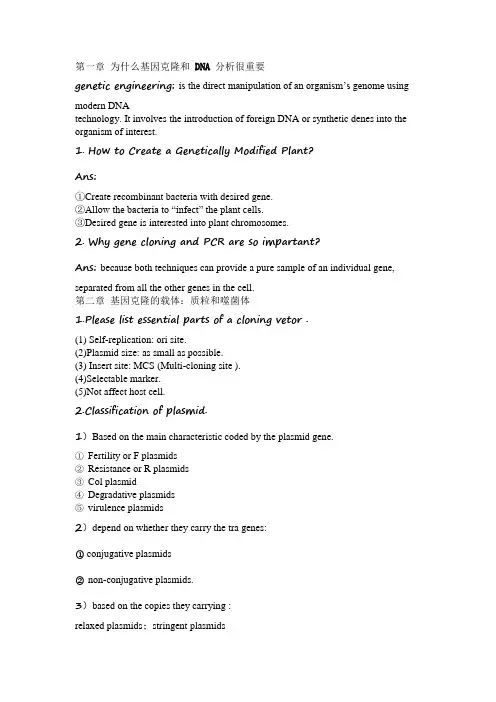
第一章为什么基因克隆和DNA 分析很重要genetic engineering: is the direct manipulation of an organism’s genome using modern DNAtechnology. It involves the introduction of foreign DNA or synthetic denes into the organism of interest.1.How to Create a Genetically Modified Plant?Ans:①Create recombinant bacteria with desired gene.②Allow the bacteria to “infect” the plant cells.③Desired gene is interested into plant chromosomes.2.Why gene cloning and PCR are so impartant?Ans: because both techniques can provide a pure sample of an individual gene, separated from all the other genes in the cell.第二章基因克隆的载体:质粒和噬菌体1.Please list essential parts of a cloning vetor .(1) Self-replication: ori site.(2)Plasmid size: as small as possible.(3) Insert site: MCS (Multi-cloning site ).(4)Selectable marker.(5)Not affect host cell.2.Classification of plasmid.1)Based on the main characteristic coded by the plasmid gene.①Fertility or F plasmids②Resistance or R plasmids③Col plasmid④Degradative plasmids⑤virulence plasmids2)depend on whether they carry the tra genes:① conjugative plasmids②non-conjugative plasmids.3)based on the copies they carrying :relaxed plasmids;stringent plasmidsWords:1. Plasmid:A usually circular piece of DNA, primarily independent of the host chromosome, often found in bacteria and some other types of cells.2. cccDNA:(covalently closed-circular DNA): A completely double-standed circular DNA molecule, with no nicks or disconuities, usually with a supercoiled conformation.3. ori(origin of replication: The specific position on a DNA molecule where DNA replication begins.4. episome: A plasmid capable of integration into the host cell's chromosome.5. copy number: The number of molecules of a plasmid contained in a single cell.6. bacteriophage:A virus whose host is a bacterium。
高中生物《基因工程》练习题(含答案解析)
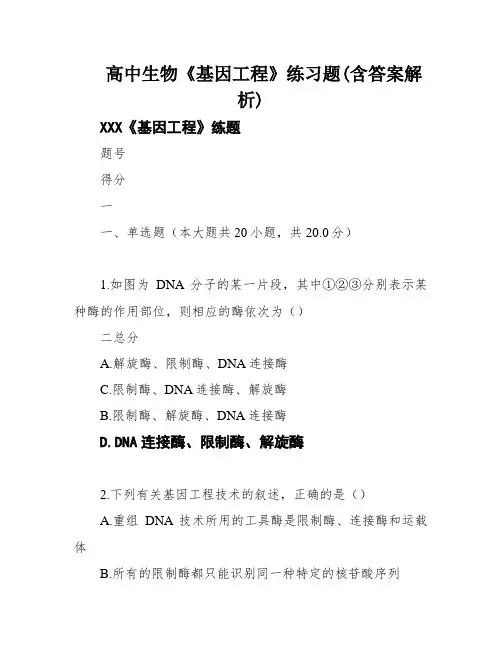
高中生物《基因工程》练习题(含答案解析)XXX《基因工程》练题题号得分一一、单选题(本大题共20小题,共20.0分)1.如图为DNA分子的某一片段,其中①②③分别表示某种酶的作用部位,则相应的酶依次为()二总分A.解旋酶、限制酶、DNA连接酶C.限制酶、DNA连接酶、解旋酶B.限制酶、解旋酶、DNA连接酶D.DNA连接酶、限制酶、解旋酶2.下列有关基因工程技术的叙述,正确的是()A.重组DNA技术所用的工具酶是限制酶、连接酶和运载体B.所有的限制酶都只能识别同一种特定的核苷酸序列C.选用细菌为重组质粒受体细胞是因为质粒易进入细菌细胞且繁殖快D.只要目的基因进入受体细胞就能成功实现表达3.如图为基因表达载体的模式图。
以下有关基因工程的说法错误的是()A.基因工程的核心步骤是基因表达载体的构建B.任何基因表达载体的构建都是一样的,没有差别C.图中启动子和终止子分歧与起始暗码子和终止暗码子D.抗生素抗性基因的作用是作为标记基因,用于鉴别受体细胞中是否导入了载体4.一些细菌能借助限制性核酸内切酶抵御外来入侵者,而其自身的基因组DNA经预先修饰能躲避限定酶的降解。
以下在动物体内发生的过程当中,与上述细菌行为相似的是()A.巨噬细胞内溶酶体杀灭病原体B.T细胞受抗原刺激分泌淋巴因子C.组织液中抗体与抗原的特异性结合D.疫苗诱导机体发生对病原体的免疫5.某目的基因两侧的DNA序列所含的限制性核酸内切酶位点如图所示,最好应选用下列哪种质粒作为载体()XXX.C.D.6.下图是研究人员使用供体生物DNA中无限增殖调控基因制备单克隆抗体的思路流程。
以下相关叙述精确的是()A.酶a、酶b作用位点分别为氢键和磷酸二酯键B.Ⅰ是经免疫的记忆细胞与骨髓瘤细胞融合的杂交瘤细胞C.筛选出既能无限增殖又能产生专一抗体的Ⅱ必须通过分子检测D.上述制备单克隆抗体的方法涉及转基因技术和动物细胞核移植技术7.下列关于基因工程技术的说法,正确的是()A.切割质粒的限制酶均只能特异性地识别3-6个核苷酸序列B.PCR反应中两种引物的碱基间应互补以保证与模板链的正常结合C.载体质粒通常采用抗生素抗性基因作为标记基因D.目的基因必须位于重组质粒的启动子和终止子之间才能进行复制8.在其他条件具备的情况下,在试管中进入物质X和物质Z,可得到相应产物Y.下列叙述正确的是()A.若X是DNA,Y是RNA,则Z是逆转录酶B.若X是DNA,Y是mRNA,则Z是脱氧核苷酸C.若X是RNA,Y是DNA,则Z是限制性内切酶D.若X是mRNA,Y是核糖体上合成的大分子,则Z是氨基酸9.下图透露表现的是三种黏性末端,以下说法精确的是A.甲、乙、丙黏性末端是由两种限制酶作用产生的B.若甲中的G处发生突变,限制酶可能无法识别该切割位点C.乙中的酶切位点在A与G之间D.目前常用的运载体有质粒、噬菌体和动植物病毒等几类原核生物10.如图是利用基因工程技术生产可使用疫苗的部分过程,其中PstⅠ、SmaⅠ、EcoRⅠ、ApaⅠ为四种限制性核酸内切酶。
基因工程技术考试试题
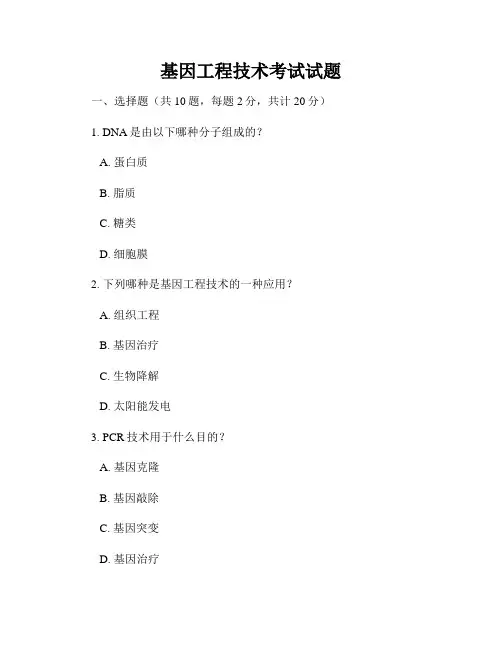
基因工程技术考试试题一、选择题(共10题,每题2分,共计20分)1. DNA是由以下哪种分子组成的?A. 蛋白质B. 脂质C. 糖类D. 细胞膜2. 下列哪种是基因工程技术的一种应用?A. 组织工程B. 基因治疗C. 生物降解D. 太阳能发电3. PCR技术用于什么目的?A. 基因克隆B. 基因敲除C. 基因突变D. 基因治疗4. 基因工程技术最早起源于哪个国家?A. 美国B. 英国C. 中国D. 日本5. 下列哪种是基因编辑的一种主要方法?A. RNA干扰B. 全基因组测序C. 基因枪D. CRISPR-Cas96. 基因工程技术在农业领域的主要应用是什么?A. 作物抗虫性改良B. 增加作物产量C. 提高作物口感D. 减少作物生长周期7. 双链RNA干扰主要用于什么目的?A. 基因敲除B. 基因突变C. 基因治疗D. 基因表达调控8. 基因工程技术在医药领域的主要应用是什么?A. 生产抗生素B. 疾病诊断C. 组织工程D. 基因改良9. 基因工程技术是否可以用于人类克隆?A. 可以B. 不可以10. 基因工程技术是否会对生态环境造成影响?A. 会B. 不会二、简答题(共5题,每题10分,共计50分)1. 请简要介绍基因工程技术的原理和主要方法。
2. 基因工程技术在农业领域的应用有哪些?请举例说明。
3. 什么是基因编辑?请详细描述CRISPR-Cas9基因编辑系统的工作原理。
4. 简要介绍基因工程技术在医药领域的应用,包括基因治疗和药物生产。
5. 基因工程技术是否存在伦理道德问题?请阐述你的观点。
三、论述题(共1题,30分)请阐述基因工程技术对人类社会和生态环境的影响,包括积极和消极两方面。
(完整版)基因工程测试
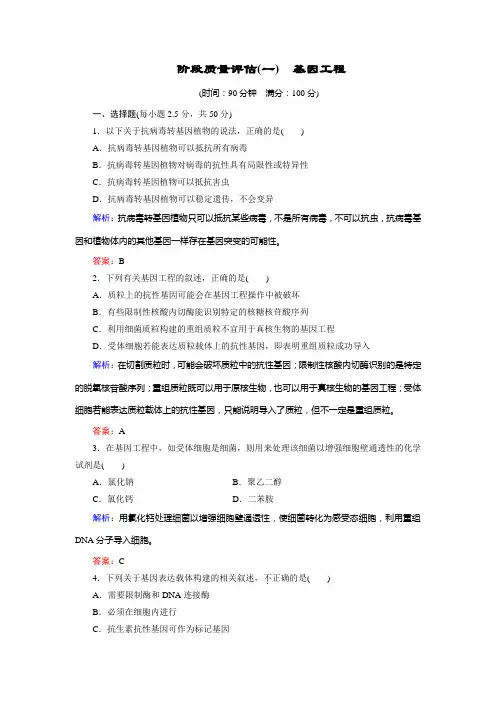
阶段质量评估(一)基因工程(时间:90分钟满分:100分)一、选择题(每小题2.5分,共50分)1.以下关于抗病毒转基因植物的说法,正确的是()A.抗病毒转基因植物可以抵抗所有病毒B.抗病毒转基因植物对病毒的抗性具有局限性或特异性C.抗病毒转基因植物可以抵抗害虫D.抗病毒转基因植物可以稳定遗传,不会变异解析:抗病毒转基因植物只可以抵抗某些病毒,不是所有病毒,不可以抗虫,抗病毒基因和植物体内的其他基因一样存在基因突变的可能性。
答案:B2.下列有关基因工程的叙述,正确的是()A.质粒上的抗性基因可能会在基因工程操作中被破坏B.有些限制性核酸内切酶能识别特定的核糖核苷酸序列C.利用细菌质粒构建的重组质粒不宜用于真核生物的基因工程D.受体细胞若能表达质粒载体上的抗性基因,即表明重组质粒成功导入解析:在切割质粒时,可能会破坏质粒中的抗性基因;限制性核酸内切酶识别的是特定的脱氧核苷酸序列;重组质粒既可以用于原核生物,也可以用于真核生物的基因工程;受体细胞若能表达质粒载体上的抗性基因,只能说明导入了质粒,但不一定是重组质粒。
答案:A3.在基因工程中,如受体细胞是细菌,则用来处理该细菌以增强细胞壁通透性的化学试剂是()A.氯化钠B.聚乙二醇C.氯化钙D.二苯胺解析:用氯化钙处理细菌以增强细胞壁通透性,使细菌转化为感受态细胞,利用重组DNA分子导入细胞。
答案:C4.下列关于基因表达载体构建的相关叙述,不.正确的是()A.需要限制酶和DNA连接酶B.必须在细胞内进行C.抗生素抗性基因可作为标记基因D.启动子位于目的基因的首端解析:基因表达载体的构建是在细胞外进行的。
答案:B5.以下甲、乙两图表示从细菌细胞中获取目的基因的两种方法,以下说法中错误的是()A.甲方法可建立该细菌的基因组文库B.乙方法可建立该细菌的cDNA文库C.甲方法要以脱氧核苷酸为原料D.乙方法需要逆转录酶参与解析:甲方法是从细菌的DNA中直接提取,故可以建立该细菌的基因组文库。
某大学《基因工程》课程考试试卷(含答案)
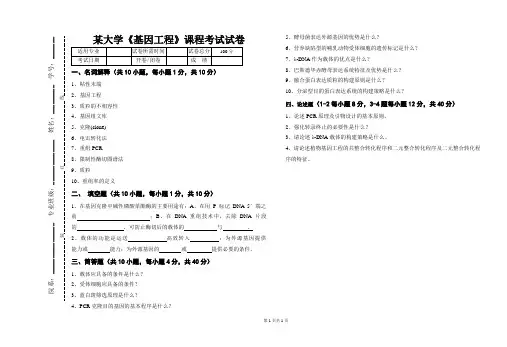
某大学《基因工程》课程考试试卷一、名词解释(共10小题,每小题1分,共10分)1、粘性末端2、基因工程3、质粒的不相容性4、基因组文库5、克隆(clone)6、电击转化法7、重组PCR8、限制性酶切图谱法9、质粒10、重组率的定义二、填空题(共10小题,每小题1分,共10分)1、在基因克隆中碱性磷酸单酯酶的主要用途有:A、在用P标记DNA 5′端之前;B、在DNA重组技术中,去除DNA片段的,可防止酶切后的载体的与。
2、载体的功能是运送高效转入;为外源基因提供能力或能力;为外源基因的或提供必要的条件。
三、简答题(共10小题,每小题4分,共40分)1、载体应具备的条件是什么?2、受体细胞应具备的条件?3、蓝白斑筛选原理是什么?4、PCR克隆目的基因的基本程序是什么?5、酵母菌表达外源基因的优势是什么?6、营养缺陷型的哺乳动物受体细胞的遗传标记是什么?7、λ-DNA作为载体的优点是什么?8、巴斯德毕赤酵母表达系统特征及优势是什么?9、融合蛋白表达质粒的构建原则是什么?10、分泌型目的蛋白表达系统的构建策略是什么?四、论述题(1-2每小题8分,3-4题每小题12分,共40分)1、论述PCR原理及引物设计的基本原则。
2、强化转录终止的必要性是什么?3、请论述λ-DNA载体的构建策略是什么。
4、请论述植物基因工程的共整合转化程序和二元整合转化程序及二元整合转化程序的特征。
某大学《基因工程》课程考试试卷答案一、名词解释(共10小题,每小题1分,共10分)1、粘性末端因酶切位点在两条DNA单链上不同(对称)酶切后形成的具有互补碱基的单链末端结构,酶切产生的两个粘性末端很容易通过互补碱基的配对而重新连接起来。
2、基因工程指重组DNA技术的产业化设计与应用,包括上游技术和下游技术两大组成部分。
上游技术指的是基因重组、克隆和表达的设计与构建(即重组DNA技术);而下游技术则涉及到基因工程菌或细胞的大规模培养以及基因产物的分离纯化过程。
基因工程习题与参考答案-2012--英汉全
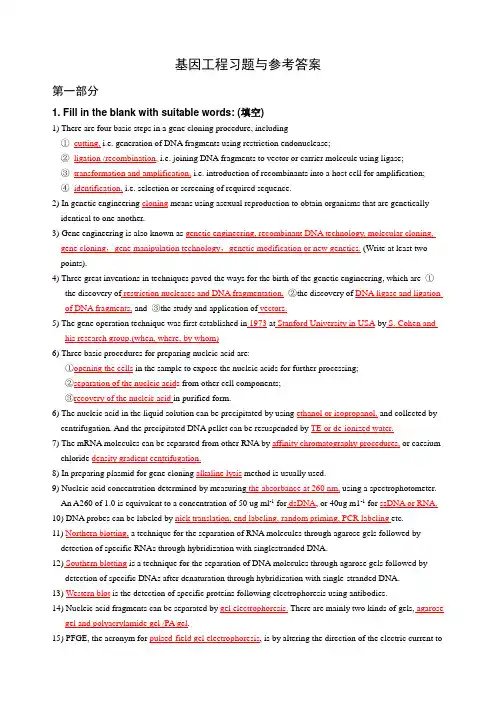
基因工程习题与参考答案第一部分1. Fill in the blank with suitable words: (填空)1) There are four basic steps in a gene cloning procedure, including①cutting, i.e. generation of DNA fragments using restriction endonuclease;②ligation /recombination, i.e. joining DNA fragments to vector or carrier molecule using ligase;③transformation and amplification, i.e. introduction of recombinants into a host cell for amplification;④identification, i.e. selection or screening of required sequence.2) In genetic engineering cloning means using asexual reproduction to obtain organisms that are genetically identical to one another.3) Gene engineering is also known as genetic engineering, recombinant DNA technology, molecular cloning, gene cloning,gene manipulation technology,genetic modification or new genetics. (Write at least two points).4) Three great inventions in techniques paved the ways for the birth of the genetic engineering, which are ①the discovery of restriction nucleases and DNA fragmentation,②the discovery of DNA ligase and ligation of DNA fragments, and ③the study and application of vectors.5) The gene operation technique was first established in 1973 at Stanford University in USA by S. Cohen andhis research group.(when, where, by whom)6) Three basic procedures for preparing nucleic acid are:①opening the cells in the sample to expose the nucleic acids for further processing;②separation of the nucleic acids from other cell components;③recovery of the nucleic acid in purified form.6) The nucleic acid in the liquid solution can be precipitated by using ethanol or isopropanol, and collected by centrifugation.And the precipitated DNA pellet can be resuspended by TE or de-ionized water.7) The mRNA molecules can be separated from other RNA by affinity chromatography procedures, or caesium chloride density gradient centrifugation.8) In preparing plasmid for gene cloning alkaline lysis method is usually used.9) Nucleic acid concentration determined by measuring the absorbance at 260 nm, using a spectrophotometer. An A260 of 1.0 is equivalent to a concentration of 50 ug ml-1 for dsDNA, or 40ug m1-1 for ssDNA or RNA.10) DNA probes can be labeled by nick translation, end labeling, random priming, PCR labeling etc.11) Northern blotting, a technique for the separation of RNA molecules through agarose gels followed by detection of specific RNAs through hybridization with singlestranded DNA.12) Southern blotting is a technique for the separation of DNA molecules through agarose gels followed bydetection of specific DNAs after denaturation through hybridization with single-stranded DNA.13) Western blot is the detection of specific proteins following electrophoresis using antibodies.14) Nucleic acid fragments can be separated by gel electrophoresis. There are mainly two kinds of gels, agarosegel and polyacrylamide gel /PA gel.15) PFGE, the acronym for pulsed-field gel electrophoresis, is by altering the direction of the electric current toalter the path of DNA molecules as they travel through the gel.16)PCR, polymerase chain reaction – cycles of DNA denaturation, primer annealing and extension with DNApolymerase lead to a amplification of the target DNA sequence. It is a technique to amplify specific(target/desired) DNA sequences in vitro.17) There are three steps in each PCR cycle. Denaturation allows two strands of the target DNA molecule areseparated at 94 ℃. Annealing allows primers to recognize and bind to the target DNA strands at the lower temperature. Extension is the use of DNA polymerase and dNTPs to synthesize a new DNA strand in a 5’ to 3’ direction at 72℃.18) In a standard PCR reaction system including the following components:①1×PCR reaction buffer (500mmol/L KCl,100mmol/L Tris.Cl pH 8.3).② MgCl2/ Mg2+.③50 μM each of dNTPs.④ a pair of primers.⑤Taq DNA polymerase (1-2 units).⑥(1pg -1ug) of DNA template.19) Primer is a short DNA or RNA sequence that is paired with one strand of DNA and provides a free 3’ hydroxyl group at which DNA replication can initiate.20) Reverse transcriptase is the enzyme that synthesizes DNA from RNA templates.21) Inverse PCR is used to amplify regions that lie outside the known region.22) S1 nuclease cleaves only single stranded DNA, including single stranded nicks in mainly double-stranded molecules.23) Isocaudamer (同尾酶) Restriction enzymes which are from different sources, recognize different DNAsequence, but produce the same sticky ends.24) Isoschizomer Restriction enzymes which recognize the same DNA sequence. They may cut at the same orat different positions within it.25) DNA Ligase is an enzyme that catalyses the formation of a phosphodiester bond between two DNA chains.There are mainly two types of them, one is T4 phage DNA ligase purified from E. coli cells infected with bacteriophage T4, another is E. coli DNA ligase saperated from E. coli.26) Vectors are autonomously replicating DNA molecules used to carry foreign DNA fragments. A vectorshould be fairly small DNA molecules, to facilitate isolation and handling; have an origin of replication, so that their DNA can be copied and maintained in the cell population as the host organism grows and divides;have some sort of selectable marker that will enable the vector to be detected; have at least one, often multiple restriction endonuclease recognition site, to enable DNA to be inserted during the production of recombinants. Also called MCS (multiple cloning site).27) Transformation refers to the introduction of extraneous DNA into a cell. It is also means the conversion ofan animal cell into immortalized, tumor-like, cell.28)Transfection refers to the introduction of phage DNA into a cell.29) The ligation of cDNA into vectors to form the recombinants can be done using the following four ligatingstrategies, depending on the ends properties. They are sticky end ligation, blunt end ligation, ligating byusing linkers or adapters and/or by homopolymer tailing.30) The DNA library size can be decided according to the formula derived by Clarke and Carbon in 1976,where N is the number of clones required. p is the probability of a particular sequence presented (0.95 or0.99); f is the ratio of genomic size to fragment size.31) Partially digested genomic DNA fragments with restriction enzyme Sau 3A can be ligated to vectors suchasλreplacement vector EMBL4, restricted with enzyme Bam H I, because both the enzymes produce the same sticky ends which are complementary. They are called isocaudamers.32) Selection is where some sort of pressure (e.g. the presence of an antibiotic) is applied during the growth ofhost cells containing recombinant DNA. The cells with the desired characteristics are therefore selected by their ability to survive. Screening is a procedure by which a population of viable cells is subjected to some sort of analysis that enables the desired sequences to be identified.33) In gene cloning the selection or/and screening methods is mainly based on one of following four criteria:①DNA sequence of the clone;②protein sequence of the encoded polypeptide;③ a biochemical function of the polypeptide;④the ability of the polypeptide encoded by the recombinant clone to interact with other polypeptides. 34)Primers used in PCR experiments needn’t match the target sequence exactly. This can be used①to make mutations;②to change the amplified DNA sequence;③to search for homologous gene sequences to one already known.35)The 3’-end of a primer must match the target sequence exactly. So, we cannot introduce mutations at the 3’-end of the primer, a favorite location to introduce changes is the 5’-end.2. What glossary best fit for the following explanation?1)Genetic engineering The formation of new combinations of heritable material by the insertion of nucleicacid molecules, produced by whatever means outside the cell, into any virus, bacterial plasmid or other vector system so as to allow their incorporation into a host organism in which they do not naturally occur but in which they are capable of continued propagation.2)Northern blotting A technique for the separation of RNA molecules through agarose gels followed bydetection of specific RNAs through hybridization with single stranded DNA.3)Southern blotting A technique for the separation of DNA molecules through agarose gels followed bydetection of specific DNAs after denaturation through hybridization with single-stranded DNA.4)Western blotting The detection of specific proteins following electrophoresis using antibodies.5)Primer A short DNA or RNA sequence that is paired with one strand of DNA and provides a free 3’hydroxyl group at which DNA replication can initiate.6)RT-PCR A method for the amplification of a specific mRNA. Reverse transcriptase is used to form acDNA which is then amplified using PCR.7)RFLP Restriction fragment length polymorphism. A difference in the length of a specific restrictionfragment found in different members of the same species. Usually caused by a small mutation whichcreates or destroys a restriction endonuclease recognition site, or by a variation in the number of repeats ofa tandemly repeated sequence.8)RAPD (randomly amplified polymorphic DNA)9)SCAR (sequence characterized amplified region)10)SSR(simple sequence repeat)11)AFLP (amplified fragment length polymorphism)12)RFLP (restriction fragment length polymorphism). A difference in the length of a specific restrictionfragment found in different members of the same species. Usually caused by a small mutation whichcreates or destroys a restriction endonuclease recognition site, or by a variation in the number of repeats ofa tandemly repeated sequence.13)STS Sequence tagged site (from sequencing RFLP ends)14)CAPS Cleaved amplified polymorphic sequence15)RACE Rapid amplification of cDNA ends16)RNA polymerase The enzyme that synthesizes RNA from a DNA template.17)TA cloning A method for cloning PCR products that relies on the addition of template independent Aresidues to PCR products by Taq DNA polymerase.18)Exonuclease An enzyme that digests a nucleic acid molecule from one or both ends.19)Endonuclease An enzyme that cuts within a nucleic acid molecule, as opposed to an exonuclease, whichdigests DNA from one or both ends.20)Restriction endonuclease/restriction enzyme A naturally occurring bacterial enzyme which recognizes andcuts DNA molecules at specific sites. Type II restriction endonucleases are used extensively in gene cloning.21)Restriction fragment A piece of DNA created by cutting DNA with a restriction endonuclease.22)Linker A short double-stranded synthetic oligonucleotide containing one or more internal restrictionenzyme recognition sites. Used to add cohesive ends to DNA molecules that have blunt ends.23)Adaptor A short double-stranded synthetic oligonucleotide with one blunt end and a nucleotide extensionthat can base pair with sticky end.24)Alkaline phosphatase An enzyme that removes 5’ phosphate groups from the ends of DNA molecules,leaving 5’ hydroxyl groups.25)Polynucleotide kinase (PNK)An enzyme that catalyses the transfer of a phosphate group onto a 5’hydroxyl group.26)Terminal transferase An enzyme that adds nucleotide residues to the 3’ terminus of an oligo- orpolynucleotide.27)Blunt ends/flush ends: DNA termini without overhanging 3’ or 5’ ends.28)Cohesive ends/sticky ends: Those ends (termini) of DNA molecules that have short complementarysequences that can stick together to join two DNA molecules. Often generated by restriction enzymes. 29)Cloning vector: A vector used for reproducing the DNA fragment is often referred to as a cloning vecto r.30)Expression vector: When a vector is used for expressing a gene contained within the cloned DNA, it iscalled an expression vector.31)Shuttle vectors: Contain not only the origin of replication and selectable marker for E. coli,but alsofunctionally similar sequences for maintenance in other hosts, so it can not only maintained in E. coli, can also replicated in other hosts.32)DNA library A collection of DNA clones containing the whole genome of an organism, part of the genomeor all of the genes expressed in a particular tissue at a particular time.33)DNA ligase An enzyme used for joining DNA molecules by the formation of a phosphodiester bondbetween a 5’ phosphate and a 3’ OH group in gene cloning.34)DNA polymerase An enzyme which synthesizes a complementary DNA strand from a DNA or RNAtemplate.35)dNTP Abbreviation for deoxynucleoside triphosphate, the building block of DNA.36)Genomic library A collection of clones which together represent the entire genome of an organism or acollection of DNA fragments, derived from the genome of an organism, cloned into a vector.37)cDNA library is a collection of double-stranded cDNA molecules contained within a vector. It containsDNA copies of mRNA and is tissue and developmental stage specific. Its formation is dependent on an RNA-dependent DNA polymerase enzyme, reverse transcriptase.38)α-complementation in mutants of E. coli which express an inactive version of β-galactosidase, subunitassembly (and enzyme activity) may be restored by the presence of a small amino-terminal fragment of the lacZ product (the a-polypeptide) usually produced from a cloning vector.39)YAC Yeast Artificial Chromosome40)BAC The abbreviation for bacterial artificial chromosomes. Artificially constructed bacterial plasmidscontaining all of the sequences required for replication of a chromosome in yeast, which can accommodate very large DNA inserts of at least 300 kb.41)HAC stands for human artificial chromosome42)PAC P1 derived artificial chromosome. A vector, based on the bacteriophage P1 genome, used to clonelarge DNA fragments in E. coli43)Electroporation is a physical way for introducing DNA into cells using an electric current.44)Nucleic acid hybridization the pairing of complementary nucleic acids (DNA–DNA or DNA– RNA).The process by which a single stranded polynucleotide molecule (DNA or RNA) base pairs with amolecule with its complementary sequence to form a doublestranded molecule.45)Insertional inactivation the destruction of the function of a gene by cloning a DNA sequence into it.46)Palindromic – a sequence of DNA that read on one strand in a 5’–3’ direction is the same as than on theother strand in a 5’–3’ direction.47)PCR – polymerase chain reaction cycles of DNA denaturation, primer annealing and extension with DNApolymerase lead to a amplification of the target DNA sequence.48)PFGE Pulsed field gel electrophoresis49)Primer A short DNA or RNA sequence that is paired with one strand of DNA and provides a free 3’hydroxyl group at which DNA replication can initiate.50)Yeast two-hybrid screen A technique to identify proteins that are able to interact with each other. It’s acloning method that reveals potential protein–protein interactions by the ability of such interactions to activate expression.51)Vector A DNA molecule that possesses the ability to self-replicate. Used to introduce foreign DNA intohost cells, where it is replicated autonomously in large quantities.52)Concatemer A polynucleotide molecule made up of repeated units of the same sequence joined end to end.53)Contig One of a series of overlapping DNA fragments produced during the course of a sequencing project,made up by assembling many smaller DNA sequences.54)cos site A sequence in a bacteriophage DNA molecule that is cut during phage maturation to producecohesive, single-stranded extensions located at the ends of the linearized genome.55)Cosmid An artificially constructed plasmid cloning vector which contains a bacteriophage cos siteenabling the vector to be packaged into bacteriophage λ for infection into E. coli, enabling relatively large DNAfragments (up to about 50 kb) to be cloned at high efficiency.56)Homologous recombination Exchange of genetic material between two similar DNA segments bybreakage and reunion, with each other, of the two DNA strands.57)Polylinker In a cloning vector, a short synthetic region containing the recognition sequences for severalrestriction enzymes. Also called a multiple cloning site.第二部分绪论、基因工程基础一、填空题1. 基因工程是20世纪70 年代发展起来的遗传学的一个分支学科。
《基因工程》习题及参考答案
《基因工程》习题及参考答案一、习题:1. What are biotechnology and genetic engineering?2. What is a gene?3. What are genetically engineered medicines?4. What do genome research and human genetics deal with?5. What potentials are held out by genetic diagnosis?6. What options are given by gene therapy?7. What is an embryo - and what is a fetus?8 What is a genetic fingerprint?9 What does the term "therapeutic cloning" mean?10 What are stem cells?11 What is a transgenic organism?12 What does xenotransplantation mean?13 How will genetic engineering be used in agriculture?14 How are genetically modified organisms assessed?15 What does the German Embryo Protection Act regulate?16. What is a genome?17. Is there a risk of bioterrorism?18. How does genetic engineering affect the environment?19. Are genetically engineered crops good for farmers?20.What is the difference between restriction digestion and restriction mapping?21.Can you combine two different restriction enzymes in the same reaction tubes todigest the DNA molecules?22.Why should we need to generate restriction mapping data?23.How many restriction enzymes available now on the market?24.Why do you consider mutagenesis in vitro as one of the most critical techniquesfor us to understand in genetic engineering class?25.How do we choose the methods for DNA modification?26.How do we choose a gene expression system?27.How can we express eukaryotic gene in E.coli?28.What should we consider before we start the recombinant protein expressionexperiment?29.What is the advantage of yeast expression system?30.What is the advantage of insect expression system?31.Why there are so many different types of vectors available for cloning?32.What is the difference between cloning vector and expression vector?33.What is a genetic fingerprint?34. 基因具体分成多少种类?35. 什么叫印记基因?36.什么叫遗传漂变?37.人类基因组图谱和初步分析结果是在哪一年公布的?38.人类基因组共有多少基因?39. 克隆羊成功的技术关键是什么?40. 有人计划将两个不同物种的动植物体细胞进行融合,然后将融合体的核移植到其中一种生物的未受精卵细胞中,进行体细胞克隆。
最新高二生物选修三 基因工程测试题 可打印 有答案讲课讲稿
基因工程测试题姓名成绩一、选择题:(每题3分,共60分)1.人的糖蛋白必须经内质网和高尔基体进一步加工合成。
通过转基因技术,可以使人的糖蛋白基因得以表达的受体细胞是 ( )。
A、人乳腺细胞B、酵母菌C、T4噬菌体D、粘质沙雷氏菌2.在用基因工程技术构建抗除草剂的转基因烟草过程中,下列操作错误的是( )。
A、用限制性核酸内切酶切割烟草花叶病毒的核酸B、用DNA连接酶连接经切割的抗除草剂基因和载体C、将重组DNA分子导入烟草细胞中D、用含除草剂的培养基筛选转基因烟草细胞3.基因治疗是指( )。
A.对有基因缺陷的细胞提供营养,从而使其恢复正常,达到治疗疾病的目的B.把健康的外源基因导入到有基因缺陷的细胞中,达到治疗疾病的目的C.运用人工诱变的方法,使有基因缺陷的细胞发生基因突变恢复正常D.运用基因工程技术,把有缺陷的基因切除,达到治疗疾病的目的4.利用外源基因在受体细胞中表达,可生产人类所需的产品。
下列选项中能说明目的基因完成表达的是( )。
A.棉花细胞中检测到载体上的标记基因 B.山羊乳腺细胞中检测到人生长激素的基因 C.大肠杆菌中检测到人胰岛素基因的mRNAD.酵母菌细胞中提取到人的干扰素5.下列一般不作为基因工程中的标记基因的是( )。
A.四环素抗性基因 B.绿色荧光蛋白基因C.产物具有颜色反应的基因 D.贮藏蛋白的基因6.下列有关质粒的叙述,正确的是( )。
A.质粒是广泛存在于细菌细胞的一种颗粒状细胞器B.质粒是细菌细胞质中能自我复制的小型环状DNA分子C.质粒只有在侵入宿主细胞后才能在宿主细胞内复制D.细菌质粒的复制过程一定是在宿主细胞外独立进行的7.在基因工程中,可依据受体细胞的类型及其生理特性来选择合适的载体,既能高效地携带目的基因进入受体细胞,又能方便地进行检测。
已知有以下几类含有不同标记基因的质粒,不可做为侵入大肠杆菌的载体的是(已知青霉素可杀死细菌,四环素可杀死支原体)( )。
8.镰刀型细胞贫血症的病因是血红蛋白基因的碱基序列发生了改变。
基因工程双语课程测试题目
3) What type of enzyme might a genetic engineer use to
4) 5)
protect a specific DNA site from restriction enzyme digestion? If you had a selection of 8-hitters and were trying to decide which to use to get longer fragments from human DNA, what would you look for in their recognition sequences to help you choose? Explain why the results of a restriction endonuclease digest are predictable.
4.
What is the difference between direct and indirect non-radioactive labeling procedures?
a) all the mRNAs expressed in a particular cell or tissue? b) the entire genome of a given species?
Quiz 9 – 2007.4.5
1. 2.
3.
How is light produced by all the nonradioactive probes we discussed in class? Name one way in which the light produced by non-radioactive probes is visualized. What name (two words) is given to collections of clones that represent:
基因工程试题及答案
基因工程试题及答案一、选择题(每题2分,共20分)1. 基因工程中常用的限制酶属于:A. 内切酶B. 外切酶C. 逆转录酶D. 连接酶答案:A2. 下列哪项不是基因工程的基本步骤?A. 目的基因的获取B. 基因表达载体的构建C. 基因的转录D. 目的基因的检测与鉴定答案:C3. 基因工程中常用的运载体是:A. 质粒B. 噬菌体C. 病毒D. 所有以上答案:D4. 基因工程中,将目的基因导入植物细胞最常用的方法是:A. 电穿孔法B. 农杆菌介导法C. 脂质体法D. 微注射法答案:B5. 基因工程中,用于筛选转化细胞的标记基因是:A. 抗生素抗性基因B. 荧光蛋白基因C. 绿色荧光蛋白基因D. 所有以上答案:D6. 基因工程中,用于连接目的基因和运载体的酶是:A. DNA聚合酶B. DNA连接酶C. 逆转录酶D. 限制酶答案:B7. 基因工程中,用于检测目的基因是否成功表达的方法是:A. PCR技术B. DNA测序C. 抗原-抗体杂交D. 所有以上答案:D8. 基因工程中,用于提高目的基因表达效率的策略是:A. 使用强启动子B. 使用弱启动子C. 增加基因拷贝数D. 所有以上答案:D9. 基因工程中,用于检测目的基因是否整合到宿主基因组中的方法是:A. 南方杂交B. 北方杂交C. 西方杂交D. 东方杂交答案:A10. 基因工程中,用于提高转基因生物安全性的措施是:A. 使用标记基因B. 使用自杀基因C. 使用屏障基因D. 所有以上答案:D二、填空题(每空1分,共20分)1. 基因工程中,限制酶能够识别并切割特定的_______序列。
答案:核苷酸2. 基因工程中,常用的运载体必须具备的条件包括自主复制、_______、标记基因和安全无害。
答案:多克隆位点3. 基因工程中,将目的基因导入微生物细胞最常用的方法是_______。
答案:转化4. 基因工程中,用于检测目的基因是否成功导入的方法是_______。
